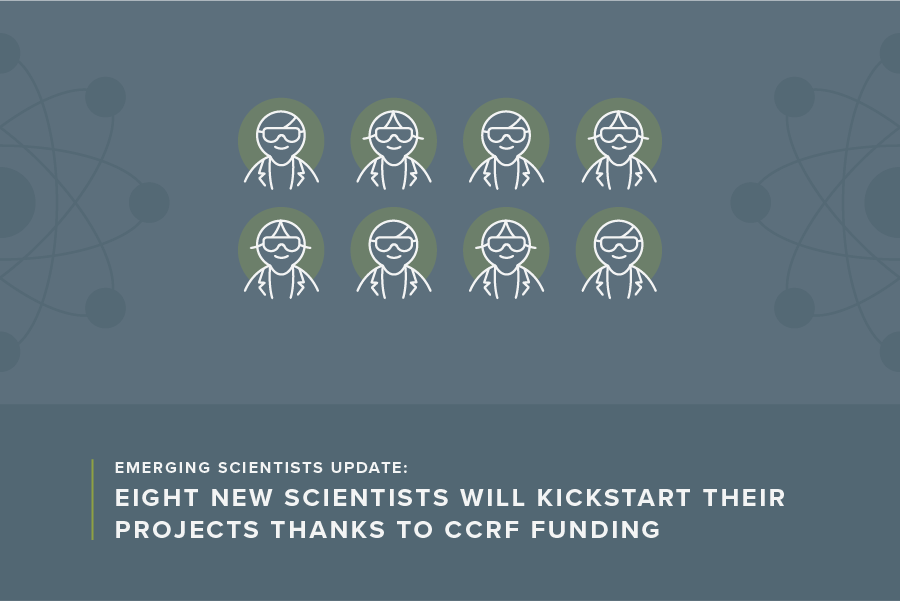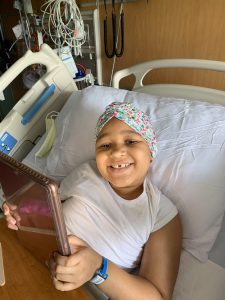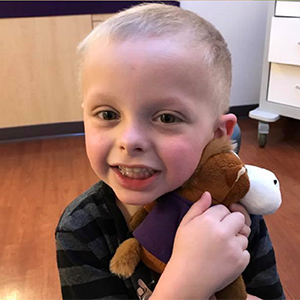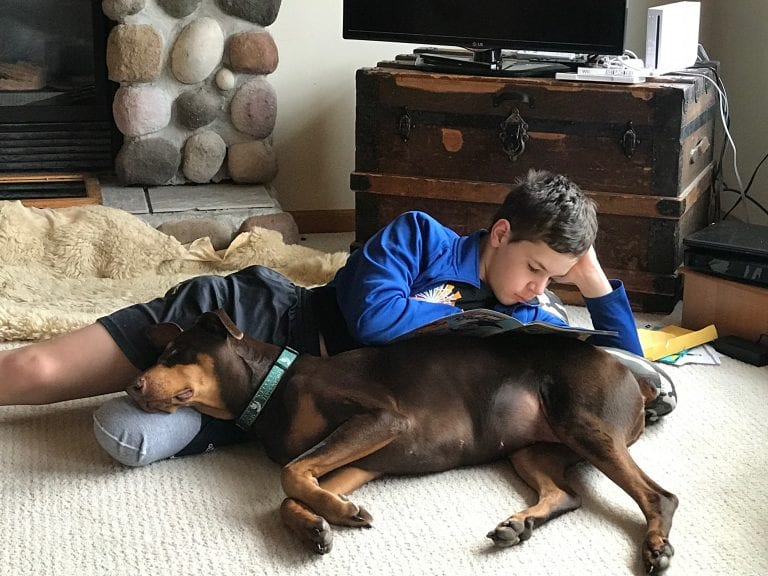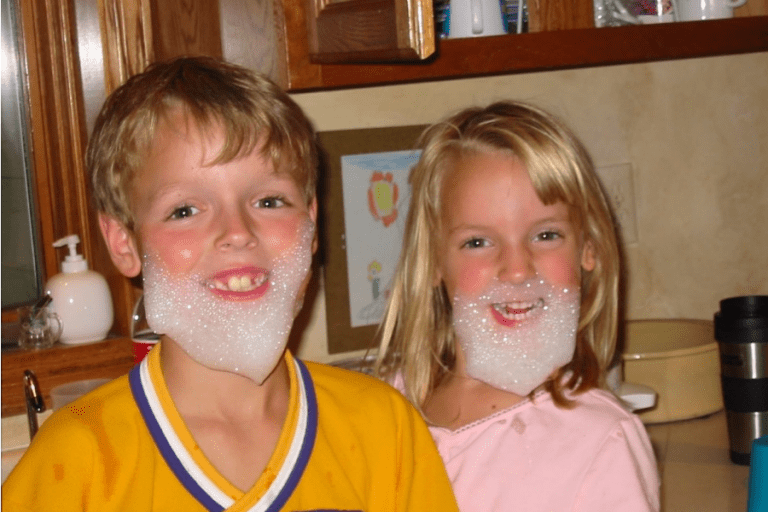Many great ideas go unexplored in the childhood cancer world due to a lack of funding. Thanks to donors like you, eight new projects are poised to kickstart in just a few weeks.
Each year, Children’s Cancer Research Fund grants young, highly qualified researchers with $100,000 to help set up their labs and launch their careers. Fewer and fewer scientists are choosing to embark on academic research, so it is more important than ever to invest in this generation of scientists today.
This year, eight up and coming researchers will launch these projects:
Studying the genes behind Acute Myeloid Leukemia (AML) to find better therapies
Shannon Conneely, MD at Baylor College of Medicine has a theory. She thinks two different groups of genes are working together to prevent current treatments, like chemotherapy and bone marrow transplants, from killing AML. With CCRF funding, Conneely plans to take a deeper look into why these genes and their actions help the cancer cells avoid dying. Once she knows how they work, she can shut the genes down, help treatments work better, and ultimately make cure rates for kids higher.
Using Artificial Intelligence to help make tough brain tumor treatment decisions
Brain tumors recently rose to the most common cause of cancer-related death in kids. Those that survive develop neurological and cognitive defects that can last a lifetime. Unfortunately, sometimes the treatment is responsible for these negative late-term effects. So, it’s up to doctors to weigh and balance the risk of not taking out tumors versus the adverse effects caused by treatment.
Volker Hovestadt, PhD and researcher at Dana-Farber Cancer Institute thinks using modern technology could help doctors make better treatment decisions. With genomic techniques and artificial intelligence, he plans to use CCRF funding to develop a model with millions of pieces of data that could predict which kids will do well with treatment and which will not. The result: better quality of life for kids facing brain tumors. His research will be one of the earliest examples of this kind of technology in action.
Enhancing communication between childhood cancer families and clinicians
Bryan Sisk, MD at Washington University in St. Louis team focuses on creating effective communication with families facing childhood cancer. This includes: helping build relationships between families and clinicians, exchanging information with families, helping them make decisions, enabling self-management, managing their uncertainty, responding to their emotions, providing validation, and supporting hope.
Each of these aspects of communication is intricately intertwined with the overall health of a child. If unmet, a child’s parents may not understand their child’s disease, they could lose trust in their doctors and experience intense anxiety. Sometimes, a lack of communication can even lead to medical harm.
Sisk has already interviewed 80 parents and 40 adolescents and young adults to gauge effective communication techniques. With CCRF funding, he plans to develop and test a model his team put together for better communication. Overall, this will be a major step toward improving relationships between clinicians and families.
Studying the impact of SMARCB1, a special protein, in rhabdoid cancers
Ninety-five percent of children with rhabdoid tumors, cancer that typically begins in the kidneys or other soft tissues, are missing a specific protein-coding gene called SMARCB1. Overall, kids with rhabdoid tumors are younger than 3 years old and survive less than a year following diagnosis.
Capucine Van Rechem, PhD at Stanford University plans to use CCRF funding to study why this protein-coding gene is so important and how it works in order to find new therapies to treat the diseases. Dr. Van Rechem has also already discovered a potential Achille’s heal for these cancers in the same environment as this protein-coding gene.
Analyzing the makeup of Hodgkin’s Lymphoma patients’ bodies to determine chemotherapy effectiveness
Chemotherapy does not work in every child’s body the same way. Aman Wadhwa, MD, MSPH at the University of Alabama at Birmingham thinks chemotherapy distribution and effectiveness may have something to do with a child’s body surface area. He plans to use CCRF funding to collect data from two already available studies and analyze how body composition, like muscle and fat mass, plays a role in how well chemotherapy works in kids with recurring Hodgkin lymphoma. Already, studies in adult cancers have shown that body composition is a predictor of cancer relapse and adverse late effects. Dr. Wadhwa will also look at how children’s body compositions change during chemotherapy treatment and whether that impacts survival.
Testing cancer targets that affect a wide range of childhood brain tumors
Robert Galvin, MD at the University of Minnesota, and his team will study two promising central nervous system genetic targets called EZH2 and B7-H3. Both of these targets are found in cancers like gliomas, medulloblastomas, ependymoma, and even subsets of rhabdoid tumors. EZH2 helps tumor cells hide from the immune system and B7-H3 turns off the immune cells within the tumor.
With CCRF funding, Dr. Galvin plans to garner more data to prove that blocking EZH2 and B7-H3 helps the immune system fight brain tumors. Once he demonstrates that the novel therapy is successful in his models, he believes it will be beneficial to patients across all diagnosis types.
Developing innovative blood technology for kids with all types of cancer
Many childhood cancer patients need blood and plasma replacements to make sure their bodies are maintaining a healthy blood balance. Typically, donors give blood to these patients, but this blood is often all pooled together from multiple donors, can be expensive, requires a lot of screening and has to be given in large quantities.
Colby Feser, PhD at the University of Minnesota plans to use CCRF funding to utilize a new gene technology called a “CRISP-Cas9 gene overexpression system” to create blood products for kids and eliminate the need for blood donors. He wants to study and develop a standardized, safe, and cost-effective blood protein concentrate to help kids who need blood. If successful, this could have a huge impact not just on childhood cancer patients, but on pediatric patients across the board.
Reviving newborn screening to catch high-risk neuroblastoma earlier
Neuroblastoma is the most common type of solid cancer in infants, and those with the high-risk form have some of the worst survival rates of all childhood cancers. Even with intensive therapy, only around half survive.
Eun Mi Jung, PhD at the University of Minnesota, plans to use CCRF support to revive early diagnostic testing for newborns. In the past, doctors used urine testing to check for special chemicals that indicated neuroblastoma. Because it failed to reduce infant mortality rates, this diagnostic testing was discontinued. Dr. Jung plans to bring back screening using dried blood spot samples and genetic data, and hopefully, improving clinical outcomes by catching tumors earlier.
Your donation supports Emerging Scientists
By donating to Children’s Cancer Research Fund, you’re giving emerging scientists the support they need to put their great ideas into practice. Learn more about CCRF's commitment to funding researchers early in their careers.

